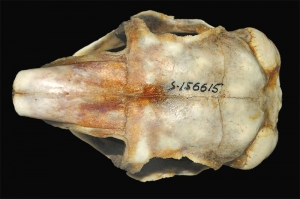History of the Sector
The Theriology Department was established in 1932 as part of the museum’s scientific and systematic division. Mammal collections were separated from the general vertebrate collection and began to be stored independently. Their catalogue, along with all accompanying documentation, was also kept separately; mammal specimens were marked with the prefix “S” before the collection number. Later, the unit was successively renamed a “section,” then a “department,” and in the museum’s current structure it is designated as the Theriology Sector.
A specimen of a springhare from the sector’s collection bears a catalogue number (“S-” followed by a sequential number in the register).
The first head of the Theriology Laboratory (later the Department) was V.G. Heptner, a renowned Soviet zoologist and researcher of the fauna of Central Asia. He served in this role until 1950, when the position was assumed by L.G. Morozova-Turova. Under her leadership, the sector abandoned the so-called “accumulation cards” and transitioned to specimen-by-specimen cataloguing, with a mandatory catalogue card created for each collection specimen.
In 1959, the department was headed by O.L. Rossolimo, who in 1970 became Director of the Zoological Museum while continuing to lead the department until 1991. During this period, the department employed such prominent theriologists as V.A. Dolgov (a specialist on insectivores) and E.N. Matyushkin (a specialist on large felids). Since 1971, I.Ya. Pavlinov has been a member of the department. Between 1986 and 1995, the department also employed E.L. Yakhontov (a specialist on dormouse-like rodents), who served as Acting Head between 1992 and 1994. From 1995 onward, the sector has been headed by I.Ya. Pavlinov.
In 1991, bat specialists A.V. Borisenko and S.V. Kruskop joined the sector, followed in 1999 by N.N. Spasskaya (a specialist on wild horses). In 2001, A.A. Lisovskiy (a specialist on lagomorphs) and A.A. Panyutina (then a student, now a recognized specialist in bat morphology and locomotion) began working in the sector. These personnel changes led to the reorganization and significant expansion of the bat collection, which became the most representative in the country. Cross-checks of other mammal collections were conducted for the first time in many years, and a unique collection of skulls of indigenous domestic horse breeds was assembled. On Panyutina’s initiative, the sector also began to collect mammalian life-traces: samples of droppings, pellets, and nesting material.
In 2004, A.V. Borisenko left the museum, moving to Canada. Shortly thereafter, upon graduation, A.A. Panyutina also departed the Zoological Museum. A.A. Lisovskiy transferred to the Sector of Evolutionary Morphology, where he became Head. At the same time, the Theriology Sector welcomed new staff: V.S. Lebedev (a specialist on hamster-like rodents, formerly at the Institute of Ecology and Evolution, RAS) and young researcher O.G. Nanova, who began actively developing geometric morphometrics as a new research direction within the sector.
In 2009, the duties of Head of the Sector were assumed by S.V. Kruskop. A year later, in 2010, N.N. Spasskaya was appointed Academic Secretary of the Museum, while continuing to supervise and, whenever possible, expand the ungulate collection.


